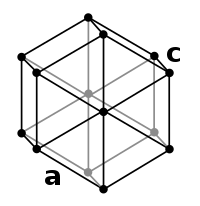
Photo from wikipedia
The huge challenge for CH4 photooxidation into CH3OH lies in the activation of the inert C-H bond and the inhibition of CH3OH overoxidation. Herein, we design two-dimensional in-plane Z-scheme heterostructures… Click to show full abstract
The huge challenge for CH4 photooxidation into CH3OH lies in the activation of the inert C-H bond and the inhibition of CH3OH overoxidation. Herein, we design two-dimensional in-plane Z-scheme heterostructures composed of two different metal oxides, with efforts to polarize the symmetrical CH4 molecules and strengthen the O-H bond in CH3OH. As a prototype, we first fabricate ZnO/Fe2O3 porous nanosheets, where high-resolution transmission electron microscopy and in situ X-ray photoelectron spectroscopy affirm their in-plane Z-scheme heterostructure. In situ Fourier transform infrared spectra and in situ electron paramagnetic resonance spectra demonstrate their higher amount of ·CH3 radicals relative to the pristine ZnO porous nanosheets, in which density functional theory calculations validate that the high local charge accumulation on Fe sites lowers the CH4 adsorption energy from 0.14 to 0.06 eV. Moreover, the charge-accumulated Fe sites strengthen the polarity of the O-H bond in CH3OH through transferring electrons to the O atoms, confirmed by the increased barrier from 0.30 to 2.63 eV for *CH3O formation, which inhibits the homolytic O-H bond cleavage and thus suppresses CH3OH overoxidation. Accordingly, the CH3OH selectivity over ZnO/Fe2O3 porous nanosheets reaches up to nearly 100% with an activity of 178.3 μmol-1 gcat-1, outperforming previously reported photocatalysts without adding any oxidants under room temperature and ambient pressure.
Journal Title: Journal of the American Chemical Society
Year Published: 2022
Link to full text (if available)
Share on Social Media: Sign Up to like & get
recommendations!